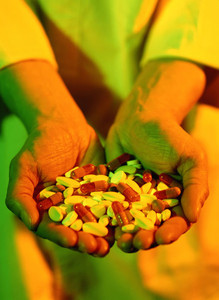Generic economics
Generic medications are generally cheaper than their branded product counterparts and so prescribing these is encouraged as a cost-containment strategy in the management of healthcare resources. Encouraging the use of generic drugs is widely considered to be the most simple and effective way of reducing medication expenditure.
Generics are generally less expensive than the brand-name drug because their manufacturers do not need to recoup the considerable research expenses incurred when an original brand is researched and brought to market. The brand-name drug has a period of exclusivity on the market due to its patent protection, but when these end, as so many currently are [1], other manufacturers are free to introduce generic versions into the marketplace at a cost far below that of the innovator.
As an example, generic and brand-name versions of anti-epileptic drugs (AEDs) are available in the United Kingdom for the following: carbamazepine, ethosuximide, gabapentin, lamotrigine, oxcarbazepine, phenytoin, topiramate, and sodium valproate. However, to remain competitive, some innovator companies have reduced the cost of their AEDs to the level charged by the generic companies and so little difference can be seen between the prices of the two. Despite this trend, the cost of the generic versions of gabapentin and lamotrigine are 78% and 86% cheaper than the original respectively (2010 data [2]).
Testing generics
A generic drug has both the same quality and quantity of active ingredients as the original formulation. They are tested to determine whether they are bioequivalent to the original, i.e. whether the active ingredient(s) are absorbed into the body at the same rate and by the same amount in bioavailability studies [2]. The thought behind this is that if there are two drugs with the same type and amount of active ingredients, then similar plasma drug concentrations will be achieved over time and ultimately result in very similar drug concentrations at the target in the body and therefore have a similar effect.
These bioequivalence tests, performed to investigate the generic’s similarity to the original, are usually performed in groups of 12 healthy volunteers or more, aged between 18–55 years [3]. Key variables under test in such studies are the drug’s maximum plasma concentration and a measure of the extent to which the body is exposed to the drug.
If a generic is decided to be ‘bioequivalent’ to its brand-name version, then the bioavailability of the generic active ingredients must be sufficiently similar to the original’s and lie within the limits defined by the authorities.
Medical concerns of generic substitution in epilepsy
A survey was taken in 2005 of 435 neurologists and general practitioners in Canada, France, Germany, Spain and the United Kingdom; 31% of respondents said that they would be uncomfortable prescribing a generic medicine for patients with epilepsy [4]. This is due to concerns of slight differences between the generic and the innovator products that could lead to a breakdown of pharmacological control, resulting in breakthrough seizures. Such differences could be in the amount and type of excipients present in the medicine and also the fact that differences in appearance, packaging, and information provided to the patient in the form of information leaflets for the different versions of the same medication may be confusing for patients [2].
Breakthrough seizures have wide-ranging consequences for both patient and health resources as the costs of managing these seizures and potential drug toxicity may outweigh any savings that were made through prescribing the cheaper medication.
AEDs represent a type of drug for which these issues are particularly important. The aim with these drugs having a narrow therapeutic index is to use the lowest dose possible that can prevent seizures with the minimal amount of unwanted side effects. Careful titration of the dose is required as individuals vary considerably and the dose needed to control seizures is sometimes very close to the level that can cause toxicity. When phenytoin is prescribed, for example, blood-level monitoring is routinely used for dose adjustment, as any small change can result in a large difference in plasma phenytoin concentrations due to its non-linear pharmacokinetic characteristics [2].
Editor’s comment
This, and the two articles that follow focus on the issues involved and the concerns that both physicians and patients may have when considering to switch from brand-name to generic versions of AEDs. What are your opinions on this issue? It is thought that if patients understood more about generic medications then the anxiety and confusion associated with their use may be avoided.
Please feel free to let us know your own personal experiences via email to editorial@gabionline.net or in the comments section below.
Related articles
Does switching to generic anti-epileptic drugs lead to loss of seizure control
Switching from a brand-name antiepileptic drug to a generic is not associated with a higher risk of seizures
References
1. GaBI Online - Generics and Biosimilars Initiative. The rise in power of generic drugs [www.gabionline.net]. Mol, Belgium: Pro Pharma Communications International; [cited 2011 Aug 12]. Available from: www.gabionline.net/Generics/Research/The-rise-in-power-of-generic-drugs/
2. Generic prescribing in epilepsy. Evid Based Med. 2010;15:65-7. doi:10.1136/dtb.2009.11.0051
3. Haskins LS, Tomaszewski KJ, Crawford P. Patient and physician reactions to generic antiepileptic substitution in the treatment of epilepsy. Epilepsy Behav. 2005 Aug;7(1):98-105.








 0
0











Post your comment